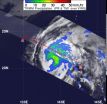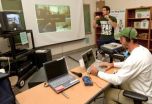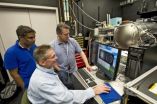(Press-News.org) Tropical Storm Sanvu strengthened overnight as forecast and is now a Typhoon in the western North Pacific Ocean. NASA's Tropical Rainfall Measuring Mission (TRMM) satellite observed that most of the rainfall is falling in the eastern half of the storm.
The TRMM satellite measured the rainfall from Typhoon Sanvu on May 24, 2012.TRMM's Microwave Imager (TMI) and Precipitation Radar (PR) data shows that Sanvu's heaviest rainfall was occurring in its northeastern quadrant where some intense storms were dropping rainfall at a rate greater than 50mm/hr (~2 inches/hr). TRMM shows that the rainfall wraps around the eastern side of the storm, stretching from north to south, while the western side of the storm is deficient in rainfall.
On May 24 at 1500 UTC (11 a.m. EDT/U.S.), Typhoon Sanvu had maximum sustained winds near 65 knots (75 mph/120.4 kph). It was about 275 nautical miles south-southwest of Iwo To, Japan, near 21.2 North and 138.9 East. Sanvu is causing high waves throughout the region, and waves have been estimated as high as 29 feet (8.8 meters). It is moving to the north at 9 knots (10.3 mph/16.6 kph).
Forecasters at the Joint Typhoon Warning Center now forecast the Sanvu will likely take a track very close to the island of Iwo To, Japan early on May 26. Iwo To was reporting thunderstorms and winds from the east-southeast by mid-day (U.S. EDT) on May 24 (May 25 local time) which are associated with the east-southeasterly flow from the approaching typhoon. As Sanvu continues to approach, thunderstorms from the typhoon will be affecting the island on May 26.
INFORMATION:
NASA's TRMM satellite sees some heavy rainfall in Typhoon Sanvu
2012-05-28
ELSE PRESS RELEASES FROM THIS DATE:
NASA satellites feed forecasters information as Bud becomes a hurricane
2012-05-28
Bud has now become the first hurricane of the eastern Pacific Hurricane Season, as NASA visible and infrared satellite imagery revealed an organized structure of spiraling thunderstorms around the eye. Watches and warnings are already in effect for southwestern Mexico as Bud nears.
The Moderate Resolution Imaging Spectroradiometer (MODIS) instrument onboard NASA's Aqua satellite captured a visible image of Hurricane Bud off the southwestern coast of Mexico on May 23 at 2035 UTC (1:35 PDT) before it reached hurricane status. The image showed the outer fringes of Bud's ...
Cyber exercise partners help you go the distance
2012-05-28
EAST LANSING, Mich. — A new study testing the benefits of a virtual exercise partner shows the presence of a moderately more capable cycling partner can significantly boost the motivation – by as much as 100 percent – to stick to an exercise program.
The research out of Michigan State University's Department of Kinesiology shows women taking part in cycling exercises exercised twice as long when working with a virtual partner, results the authors said can be used to help people meet physical activity recommendations.
The work by Brandon Irwin and colleagues is published ...
Stanford psychologists examine how race affects juvenile sentencing
2012-05-28
When it comes to holding children accountable for crimes they commit, race matters.
According to a new study by Stanford psychologists, if people imagine a juvenile offender to be black, they are more willing to hand down harsher sentences to all juveniles.
"These results highlight the fragility of protections for juveniles when race is in play," said Aneeta Rattan, lead author of the study, which appears this week in the journal PLoS ONE.
Historically, the courts have protected juveniles from the most severe sentences. It has been recognized that children are different ...
A nanoclutch for nanobots
2012-05-28
Chinese researchers have designed and tested simulations of a "nanoclutch," a speed regulation tool for nanomotors. The nanoclutch consists of two carbon nanotubes (CNTs), one inside the other, separated by a film of water. Electrowetting forces control the friction between the water and the inner and outer walls of the CNTs. When the two tubes are electrically charged, the water confined between them can transmit the torque from the inner tube to the outer tube, and the device is said to be in the engaged state. When the CNTs are uncharged, the device is in the disengaged ...
Sound increases the efficiency of boiling
2012-05-28
Scientists at the Georgia Institute of Technology achieved a 17-percent increase in boiling efficiency by using an acoustic field to enhance heat transfer. The acoustic field does this by efficiently removing vapor bubbles from the heated surface and suppressing the formation of an insulating vapor film. As reported in the American Institute of Physics' (AIP) journal the Physics of Fluids, bubble removal was enhanced because the acoustic field induces capillary waves on the bubble, causing its contact line to contract and detach the bubble from the surface. The mechanisms ...
Slip-and-slide power generators
2012-05-28
Researchers from Vestfold University College in Norway have created a simple, efficient energy harvesting device that uses the motion of a single droplet to generate electrical power. The new technology could be used as a power source for low-power portable devices, and would be especially suitable for harvesting energy from low frequency sources such as human body motion, write the authors in a paper accepted to the American Institute of Physics' (AIP) journal Applied Physics Letters. The harvester produces power when an electrically conductive droplet (mercury or an ionic ...
Tiny planet-finding mirrors borrow from Webb Telescope playbook
2012-05-28
NASA's next flagship mission — the James Webb Space Telescope — will carry the largest primary mirror ever deployed. This segmented behemoth will unfold to 21.3 feet in diameter once the observatory reaches its orbit in 2018.
A team of scientists at NASA's Goddard Space Flight Center in Greenbelt, Md., now is developing an instrument that would image and characterize planets beyond the solar system possibly from a high-altitude balloon has borrowed a page from the Webb telescope's playbook. It has created an infinitely smaller segmented mirror that currently measures ...
Scientists evaluate different antimicrobial metals for use in water filters
2012-05-28
Porous ceramic water filters are often coated with colloidal silver, which prevents the growth of microbes trapped in the micro- and nano-scale pores of the filter. Other metals such as copper and zinc have also been shown to exhibit anti-microbial activity. Researchers from Princeton University in New Jersey used atomic force microscopy (AFM) measurements to study the adhesion interaction between Escherichia coli (E. coli) bacteria and colloidal silver, silver nanoparticles, and copper nanoparticles, as well as the interactions of the bacteria and the three different types ...
'Personality genes' may help account for longevity
2012-05-28
VIDEO:
Nir Barzilai, M.D., discusses his new research on how personality traits like being outgoing, optimistic, easygoing, and enjoying laughter as well as staying engaged in activities may also be part...
Click here for more information.
May 24, 2012 – (BRONX, NY) – "It's in their genes" is a common refrain from scientists when asked about factors that allow centenarians to reach age 100 and beyond. Up until now, research has focused on genetic variations that offer a physiological ...
Asteroid nudged by sunlight: Most precise measurement of Yarkovsky effect
2012-05-28
Scientists on NASA's asteroid sample return mission, Origins, Spectral Interpretation, Resource Identification, Security, Regolith Explorer (OSIRIS-REx), have measured the orbit of their destination asteroid, 1999 RQ36, with such accuracy they were able to directly measure the drift resulting from a subtle but important force called the Yarkovsky effect – the slight push created when the asteroid absorbs sunlight and re-emits that energy as heat.
"The new orbit for the half-kilometer (one-third mile) diameter 1999 RQ36 is the most precise asteroid orbit ever obtained," ...




